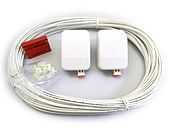Plastic optical fiber

Plastic optical fiber (POF) (or Polymer optical fibre) is an optical fiber which is made out of plastic. Traditionally PMMA (acrylic) is the core material, and fluorinated polymers are the cladding material. Since the late 1990s however, much higher-performance POF based on perfluorinated polymers (mainly polyperfluorobutenylvinylether) has begun to appear in the marketplace.
In large-diameter fibers, 96% of the cross section is the core that allows the transmission of light. Similar to traditional glass fiber, POF transmits light (or data) through the core of the fiber. The core size of POF is in some cases 100 times larger than glass fiber.
POF has been called the "consumer" optical fiber because the fiber and associated optical links, connectors, and installation are all inexpensive. Due to the attenuation and distortion characteristics of the traditional PMMA fibers are commonly used for low-speed, short-distance (up to 100 meters) applications in digital home appliances, home networks, industrial networks (PROFIBUS, PROFINET), and car networks (MOST). The perfluorinated polymer fibers are commonly used for much higher-speed applications such as data center wiring and building LAN wiring.
In relation to the future request of high-speed home networking, there has been an increasing interest in POF as a possible option for next-generation Gigabit/s links inside the house. To this end, several European Research projects are active, such as POF-ALL and POF-PLUS . Several standardization bodies at country, European and WW levels are currently developing Gigabit communication standards for POF aimed towards Home networking applications. It is expected the release at the beginning of 2012. One future Gigabit POF standard is based on multilevel PAM modulation a frame structure, Tomlinson-Harashima Precoding and Multilevel coset coding modulation. The combination of all these techniques has proven to be an efficient way of achieving low cost implementations at the same time that the transmission theoretical maximum capacity of the POF is approached. Since 2014 a full family of PHY transceivers are available in the market enabling the design and manufacturing of home networking equipment truly delivering Gigabit speeds into the home. Other alternatives are schemes like DMT, PAM-2 NRZ, DFE equalization or PAM-4. VDE standard was published in 2013.[1] After the publication the IEEE ask VDE to withdrawn the specification and bring all the effort to IEEE. VDE withdrawn the specification and a CFI was presented to IEEE on March 2014.[2] IEEE study group has been meeting since then.
For telecommunications, the more difficult-to-use glass optical fiber is more common. This fiber has a core made of germania-doped silica. Although the actual cost of glass fibers are similar to the plastic fiber, their installed cost is much higher due to the special handling and installation techniques required.
One of the most exciting developments in polymer fibers has been the development of microstructured polymer optical fibers (mPOF), a type of photonic crystal fiber. POF fiber also has applications in sensing. It is possible to write fiber Bragg gratings in single and multimode POF. There are advantages in doing this over using silica fiber since the POF can be stretched further without breaking, some applications are described in the PHOSFOS project page.
POF in short:
- PMMA and Polystyrene are used as fiber core, with refractive indices of 1.49 and 1.59 respectively.
- Generally, fiber cladding is made of silicone resin (refractive index ~1.46).
- High refractive index difference is maintained between core and cladding.
- High numerical aperture.
- Have high mechanical flexibility and low cost.
- Attenuation loss is about 1 dB/m @ 650 nm.[3]
- Bandwidth is ~5 MHz-km @ 650 nm.[3]
References
- ↑ https://www.vde-verlag.de/standards/0800061/din-vde-v-0885-763-vde-v-0885-763-2013-09.html
- ↑ www
.ieee802 .org /3 /GEPOFSG /public /CFI /GigPOF%20CFI%20v _1 _0 .pdf - ↑ 3.0 3.1 "The FOA Reference For Fiber Optics - Optical Fiber". thefoa.org. 2011-02-12. Retrieved 2013-08-24.
Literature
- C.M.Okonkwo, E. Tangdiongga, H. Yang, D. Visani, S. Loquai, R. Kruglov, B. Charbonnier, M. Ouzzif, I. Greiss, O. Ziemann, R. Gaudino, A. M. J. Koonen, "Recent Results From the EU POF-PLUS Project: Multi-Gigabit Transmission Over 1 mm Core Diameter Plastic Optical Fibers" Vol. 29., No.2., pp186–193 January 2011.
- Ziemann, O., Krauser, J., Zamzow, P.E., Daum, W.: POF Handbook - Optical Short Range Transmission Systems. 2nd ed., 2008, Springer, 884 p. 491 illus. in color, ISBN 978-3-540-76628-5
- I. Möllers, D. Jäger, R. Gaudino, A. Nocivelli, H. Kragl, O. Ziemann, N. Weber, T. Koonen, C. Lezzi, A. Bluschke, S. Randel, “Plastic Optical Fiber Technology for Reliable Home Networking – Overview and Results of the EU Project POF-ALL,” IEEE Communications Magazine, Optical Communications Series, Vol.47, No.8, pp. 58–68, August 2009
- R. Pérez de Aranda, O. Ciordia, C. Pardo, “A standard for Gigabit Ethernet over POF. Product Implementation”, Proc. of POF Conference 2011. Bilbao
- S. Randel, C. Bunge, “Spectrally Efficient Polymer Optical Fiber Transmission”, Coherent Optical Communications, Subsystems and Systems, Proc. of SPIE Vol. 7960